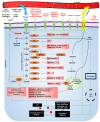Hyperglycemia Associated Metabolic and Molecular Alterations in Cancer Risk, Progression, Treatment, and Mortality
- PMID: 31546918
- PMCID: PMC6770430
- DOI: 10.3390/cancers11091402
Hyperglycemia Associated Metabolic and Molecular Alterations in Cancer Risk, Progression, Treatment, and Mortality
Abstract
Cancer and diabetes are amongst the leading causes of deaths worldwide. There is an alarming rise in cancer incidences and mortality, with approximately 18.1 million new cases and 9.6 million deaths in 2018. A major contributory but neglected factor for risk of neoplastic transformation is hyperglycemia. Epidemiologically too, lifestyle patterns resulting in high blood glucose level, with or without the role of insulin, are more often correlated with cancer risk, progression, and mortality. The two conditions recurrently exist in comorbidity, and their interplay has rendered treatment regimens more challenging by restricting the choice of drugs, affecting surgical consequences, and having associated fatal complications. Limited comprehensive literature is available on their correlation, and a lack of clarity in understanding in such comorbid conditions contributes to higher mortality rates. Hence, a critical analysis of the elements responsible for enhanced mortality due to hyperglycemia-cancer concomitance is warranted. Given the lifestyle changes in the human population, increasing metabolic disorders, and glucose addiction of cancer cells, hyperglycemia related complications in cancer underline the necessity for further in-depth investigations. This review, therefore, attempts to shed light upon hyperglycemia associated factors in the risk, progression, mortality, and treatment of cancer to highlight important mechanisms and potential therapeutic targets.
Keywords: Hyperglycemia; cancer; chemotherapy; diabetes; glucose; metabolism; mortality; risk.
Conflict of interest statement
The authors declare that they have no competing interests.
Figures


Similar articles
-
Report of the Committee on the classification and diagnostic criteria of diabetes mellitus.Diabetes Res Clin Pract. 2002 Jan;55(1):65-85. doi: 10.1016/s0168-8227(01)00365-5. Diabetes Res Clin Pract. 2002. PMID: 11755481
-
[Drawing up guidelines for the attendance of physical health of patients with severe mental illness].Encephale. 2009 Sep;35(4):330-9. doi: 10.1016/j.encep.2008.10.014. Epub 2009 Jul 9. Encephale. 2009. PMID: 19748369 French.
-
Control of post-prandial hyperglycemia--an essential part of good diabetes treatment and prevention of cardiovascular complications.Nutr Metab Cardiovasc Dis. 2002 Apr;12(2):98-107. Nutr Metab Cardiovasc Dis. 2002. PMID: 12189909 Review.
-
Feeding the critically ill obese patient: a systematic review protocol.JBI Database System Rev Implement Rep. 2015 Oct;13(10):95-109. doi: 10.11124/jbisrir-2015-2458. JBI Database System Rev Implement Rep. 2015. PMID: 26571286
-
Hyperglycemia, a neglected factor during cancer progression.Biomed Res Int. 2014;2014:461917. doi: 10.1155/2014/461917. Epub 2014 Apr 17. Biomed Res Int. 2014. PMID: 24864247 Free PMC article. Review.
Cited by
-
Tumor acidity: From hallmark of cancer to target of treatment.Front Oncol. 2022 Aug 29;12:979154. doi: 10.3389/fonc.2022.979154. eCollection 2022. Front Oncol. 2022. PMID: 36106097 Free PMC article. Review.
-
SGLT2 Inhibitors as Potential Anticancer Agents.Biomedicines. 2023 Jun 30;11(7):1867. doi: 10.3390/biomedicines11071867. Biomedicines. 2023. PMID: 37509506 Free PMC article. Review.
-
Characterization of Hormone-Dependent Pathways in Six Human Prostate-Cancer Cell Lines: A Gene-Expression Study.Genes (Basel). 2020 Oct 7;11(10):1174. doi: 10.3390/genes11101174. Genes (Basel). 2020. PMID: 33036464 Free PMC article.
-
Gut Microbiome Alterations and Hepatic Metabolic Flexibility in the Gansu Zokor, Eospalax cansus: Adaptation to Hypoxic Niches.Front Cardiovasc Med. 2022 Mar 23;9:814076. doi: 10.3389/fcvm.2022.814076. eCollection 2022. Front Cardiovasc Med. 2022. PMID: 35402538 Free PMC article.
-
High Glucose Increases DNA Damage and Elevates the Expression of Multiple DDR Genes.Genes (Basel). 2023 Jan 5;14(1):144. doi: 10.3390/genes14010144. Genes (Basel). 2023. PMID: 36672885 Free PMC article.
References
Publication types
Grants and funding
LinkOut - more resources
Full Text Sources

